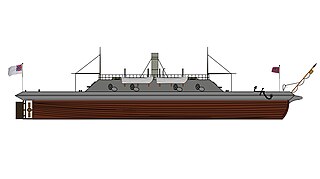
CSS Charleston was a casemate ironclad ram built for the Confederate Navy (CSN) at Charleston, South Carolina during the American Civil War. Funded by the State of South Carolina as well as donations by patriotic women's associations in the city, she was turned over to the Confederate Navy and defended the city until advancing Union troops that threatened Charleston caused her to be destroyed in early 1865 lest she be captured. Her wreck was salvaged after the war and the remains have been obliterated by subsequent dredging.

The Battery is a landmark defensive seawall and promenade in Charleston, South Carolina. Named for a civil-war coastal defense artillery battery at the site, it stretches along the lower shores of the Charleston peninsula, bordered by the Ashley and Cooper Rivers, which meet here to form Charleston harbor.

Court House Square is the location of Charleston County Courthouse in downtown Charleston, South Carolina, at the intersection of Meeting and Broad Streets. It is historically known as "the Four Corners of Law" because the intersection hosted buildings from each level of government: the Courthouse, City Hall, the Federal Building and U.S. Post Office, and Saint Michael's Episcopal Church.

The Charleston Museum is a museum located in the Wraggborough neighborhood in Charleston, South Carolina. It is one of the oldest museums in the United States. Its highly regarded collection includes historic artifacts, natural history, decorative arts and two historic Charleston houses.

WMGL is a commercial FM radio station licensed to Ravenel, South Carolina, and serving the Charleston metropolitan area and South Carolina Lowcountry. It broadcasts an urban adult contemporary radio format and calls itself "Magic 107.3." It is owned by Cumulus Media Inc., through its licensee Radio License Holding CBC, LLC. The radio studios and offices are on Faber Place Drive in North Charleston. On weekdays, WMGL carries two nationally syndicated programs, The Rickey Smiley Morning Show and The D.L. Hughley Show.

St. Mary of the Annunciation Roman Catholic Church is the first Roman Catholic parish in the Carolinas and Georgia. The current building at 93 Hasell St. in Charleston, South Carolina, is the third structure to house the congregation on this site.

Historic Charleston Foundation (HCF) was founded in 1947 to preserve and protect the integrity of architectural, historical and cultural heritage of Charleston, South Carolina, United States. The Foundation undertakes advocacy, participation in community planning, educational and volunteer programs, the preservation of historic places, research, and technical and financial assistance programs for the preservation of historic properties. Winslow Hastie has been the President & CEO of Historic Charleston Foundation since 2018.

Pink House is a historic house and art gallery at 17 Chalmers Street in Charleston, South Carolina that is one of the oldest buildings in South Carolina and is the second oldest residence in Charleston after the Colonel William Rhett House.

The Albert Sottile House is a Victorian house at 11 College St., Charleston, South Carolina. The house was built by Samuel Wilson in 1890, a prominent merchant and banker. The architect of the house was S.W. Foulk of Richmond, Virginia.
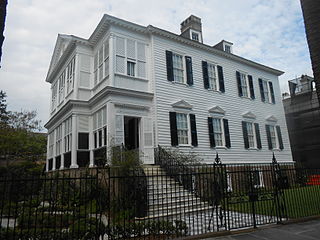
The William Washington House is a pre-Revolutionary house at 8 South Battery, Charleston, South Carolina. It is the only pre-Revolutionary house on Charleston's Battery. Thomas Savage bought the lot at the southwest corner of Church St. and South Battery in 1768 and soon built his house there. The resulting structure is a nationally important, Georgian style, square, wooden, two-story house on a high foundation.

The Rev. Robert Smith House is a pre-Revolutionary house at 6 Glebe St., Charleston, South Carolina which is used as the official residence for the president of the College of Charleston. The present use is an odd twist of history; Rev. Robert Smith, whose name has been given to the house, was the first Episcopal bishop of South Carolina and was also himself the first president of the College of Charleston.
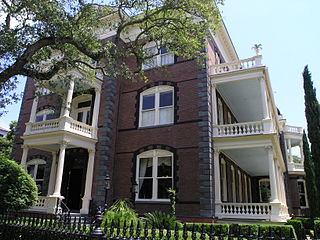
The Williams Mansion is a Victorian house at 16 Meeting St., Charleston, South Carolina. The mansion is open for public tours.

The Louis DeSaussure House is an antebellum house at 1 East Battery, Charleston, South Carolina. The house was designed and built for Louis DeSaussure by William Jones and completed in late 1859. The three-story, masonry house follows a traditional side hall plan; two adjacent parlors are fronted with piazzas along the south side while a stair hall runs along the north side with a front door facing east onto East Battery. In 1865 during the Civil War, the house was damaged when evacuating Confederate forces blew up a large cannon at the corner of East Battery and South Battery; a piece of the cannon was lodged in the attic of the house. The balconies on the East Battery façade and window ornaments were installed when the house was restored after the earthquake of 1886 by Bernard O'Neill, who bought it in 1888. The house was used by the military to house Navy officers during World War II and was later converted into apartments. The carriage house for 1 East Battery was later subdivided into a separate house known as 2 South Battery.

The Ralph Izard is a pre-Revolutionary house at 110 Broad St., Charleston, South Carolina. Although the house is known as the Ralph Izard House, it was likely built by a former owner, William Harvey. The house was listed in the will of Izard of September 1757, but Izard had only acquired the parcel three months before his death.
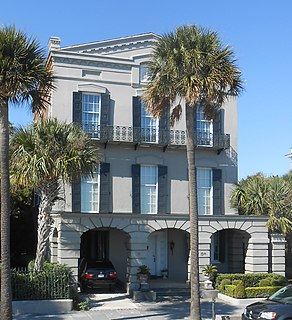
The William Ravenel House is an historic house in Charleston, South Carolina.

The Robert Gibbes House in Charleston, South Carolina, was built in the Adamesque style at least by the time Robert Gibbes, Jr. was occupying it in 1819, perhaps earlier.

Vanderhorst Row in Charleston, South Carolina is a three-unit residential building built in 1800 by Arnoldus Vanderhorst, a governor of South Carolina (1792-1794). Each unit is four floors. The units at the north and south end of the range have doors along East Bay Street on the front in addition to doors on the sides of the unified building and exits to the rear. After the Civil War, the use of the building changed, and commercial purposes were installed. The building fell into disrepair before it was bought in 1935 by Josiah E. Smith for a restoration which cost $30,000. The architect for the restoration of the building was Stephen Thomas. The three units rented for $1500 to $1800 a year after the work was completed. As restored, each unit had a living room, dining room, kitchen, breakfast room, and pantry on the first floor; a drawing room, bedroom, and bath on the second; two more bedrooms on the third; and servants' rooms in the attic. For many years after the restoration of the building, the central unit was rented by the Charleston Club for its headquarters; the club relocated to 53 East Bay Street in 1958.

The Col. John A.S. Ashe House is a historic home in Charleston, South Carolina along Charleston's Battery. Col. John A.S. Ashe, Jr. received the property upon which 26 South Battery is built upon his father's death in 1828 along with $10,000 for the construction of a house. Col. John A.S. Ashe, Jr.'s father had built the nearby Col. John Ashe House at 32 South Battery in the 1780s.
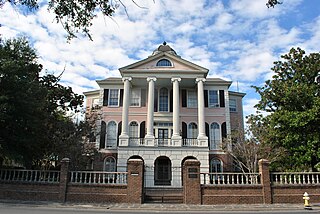
The Faber-Ward House is a historic three-story home in Charleston, South Carolina. Henry F. Faber built the house about 1832 in a Palladian style reminiscent of Southern plantations. The house was converted into a hotel for African-Americans after the American Civil War and then a middle-class residence.

The Capers-Motte House is a pre-Revolutionary house at 69 Church Street in Charleston, South Carolina. The house was likely built before 1745 by Richard Capers. Later, the house purchased and became the home of Colonel Jacob Motte, who served as the treasurer of the colony for 27 years until his death in 1770. His son, also named Jacob Motte, married Rebecca Brewton, daughter of goldsmith Robert Brewton and sister of Miles Brewton, a wealthy slave trader.




















